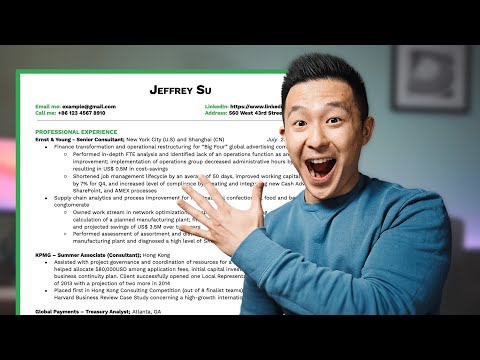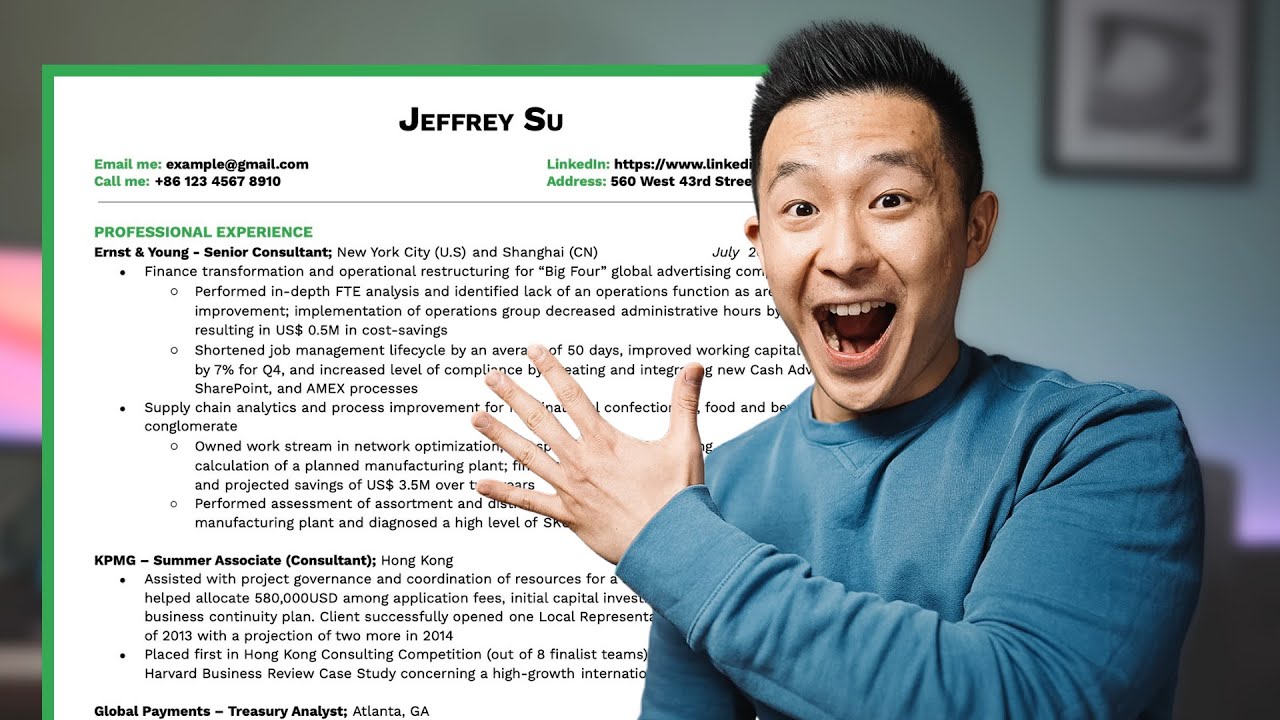Are you struggling to create an impressive resume that captures the attention of potential employers? Look no further! This comprehensive guide will equip you with the essential tips and tricks to craft a winning resume that showcases your skills and experiences effectively. Discover the key elements that can help you stand out from the competition, such as tailoring your resume to match the specific job requirements, highlighting your achievements rather than just listing your responsibilities, and incorporating action verbs to make your accomplishments more impactful. Learn how to format your resume in a visually appealing way, using bold and italicized text strategically to draw attention to the most important details. Additionally, we will guide you on how to include relevant keywords and phrases that can pass through automated applicant tracking systems. Don’t forget to quantify your accomplishments with specific numbers and percentages to demonstrate your tangible contributions. With our expert advice, you’ll be able to create a compelling resume that piques the interest of employers and increases your chances of landing your dream job.

What to Include on a Resume
| Section | Content |
|---|---|
| Contact Information | Include your full name, phone number, email address, and professional social media links (such as LinkedIn). |
| Objective Statement | Write a concise statement summarizing your career goals and how you can contribute to the organization you are applying to. |
| Summary of Qualifications | Highlight your key skills, experiences, and achievements relevant to the job you are seeking. Make sure to match these qualifications with the job requirements. |
| Education | List your educational background, including the degrees earned, the institutions attended, and any academic honors or awards received. |
| Work Experience | Provide a detailed overview of your previous work experiences, including job titles, company names, dates of employment, and a brief description of your responsibilities and accomplishments. |
| Skills | Enumerate the relevant technical and soft skills you possess, showcasing your proficiency in areas pertinent to the desired position. |
| Achievements and Certifications | Highlight any noteworthy achievements, certifications, or professional development courses that demonstrate your dedication and expertise in your field. |
| References | Include references from previous employers or professional contacts who can vouch for your abilities and character. Ensure you have their permission before listing their names. |
Resume Mastery: Unleash Your Potential with 5 Golden Rules!
What to Include on a Resume
When it comes to crafting a resume, it’s important to include the right information that will grab the attention of potential employers. Your resume serves as a snapshot of your qualifications and experiences, so it’s crucial to make it stand out from the crowd. In this article, we will discuss five compelling headings that you should consider including on your resume to make it truly shine.
Contact Information
The first section of your resume should always include your contact information. This includes your full name, phone number, email address, and physical address. Make sure to use a professional email address that consists of your name rather than a casual or outdated one. Additionally, include links to your professional social media profiles, such as LinkedIn, if applicable. By providing clear and accurate contact information, you make it easy for potential employers to get in touch with you.
Summary or Objective Statement
A summary or objective statement is a brief introduction that highlights your key qualifications, skills, and career goals. This section should be tailored to the specific job you are applying for and should emphasize how you can contribute to the company’s success. Keep it concise and avoid using generic phrases. Instead, focus on showcasing your unique strengths and what sets you apart from other candidates. A well-crafted summary or objective statement can make a strong first impression and entice employers to delve deeper into your resume.
Education
Your educational background is an essential component of your resume. Include the names of the institutions you attended, the degrees you obtained, and any relevant coursework or academic achievements. If you have recently graduated or have limited work experience, placing the education section near the top of your resume can help compensate for the lack of professional experience. However, if you have several years of work experience, you can place this section lower on your resume.
Work Experience
Your work experience section should showcase your professional history and highlight your accomplishments in previous roles. Start with your most recent or current job and work backward. For each position, include the company name, job title, dates of employment, and a brief description of your responsibilities and achievements. Use action verbs to describe your tasks and quantify your accomplishments whenever possible. This section provides employers with a clear understanding of your skills and how you have contributed to past employers’ success.
Skills and Certifications
In this section, outline your relevant skills, both technical and soft. Include any certifications or licenses you have obtained that are relevant to the position you are applying for. These could include proficiency in specific computer programs, foreign language fluency, or industry-specific certifications. Be honest about your level of proficiency in each skill, as employers may test your abilities during the interview process. Including a skills and certifications section helps employers quickly assess whether you possess the necessary qualifications for the job.
In conclusion, a well-crafted resume can significantly increase your chances of landing your dream job. By including the right information under these five headings, you can create a resume that highlights your qualifications and captures the attention of potential employers. Remember to tailor your resume to each specific job application to ensure that you are showcasing the skills and experiences most relevant to the position. With a polished and comprehensive resume, you will be well on your way to securing the job you desire.
Items to Include on a Resume:
Frequently Asked Questions
What are the essential sections to include on a resume?
1. Contact Information: Include your full name, phone number, email address, and professional social media links if applicable.
2. Summary or Objective Statement: A brief overview of your skills, qualifications, and career goals.
3. Work Experience: List your previous work positions, including job titles, company names, dates of employment, and a bulleted list of your responsibilities and accomplishments.
4. Education: Mention your educational background, including degrees earned, institutions attended, and relevant coursework or certifications.
5. Skills: Highlight your relevant skills, both technical and soft skills, that are applicable to the job you are applying for.
6. Additional Sections: Depending on your experience, you may include additional sections such as projects, publications, volunteer work, or professional affiliations.
By including these sections, you can provide a comprehensive overview of your qualifications to potential employers.
How should I format my work experience on a resume?
1. Start with your most recent position and work backwards in reverse chronological order.
2. Include the job title, company name, dates of employment (month and year), and location for each position.
3. Use bullet points to describe your responsibilities and accomplishments for each job. Focus on quantifiable achievements, such as increased sales, cost savings, or successful projects.
4. Use action verbs to begin each bullet point, such as ‘managed,’ ‘developed,’ or ‘implemented.’
5. Keep the descriptions concise and specific, highlighting the most relevant information for the job you are applying for.
6. If you have limited work experience, you can also include internships, volunteer work, or relevant coursework to showcase your skills and abilities.
By following these formatting guidelines, you can effectively showcase your work experience and impress potential employers.
Should I include a summary or objective statement on my resume?
1. Summary Statement: A summary statement provides a brief overview of your skills, qualifications, and career goals. It can be especially useful if you have significant experience or are changing careers. Use this section to highlight your most relevant skills and accomplishments.
2. Objective Statement: An objective statement states your career goals and the type of position you are seeking. This can be helpful if you are just starting your career or targeting a specific job or industry.
3. Tailor to the Job: If you choose to include a summary or objective statement, make sure to customize it for each job application. Highlight the skills and experiences that align with the job requirements.
4. Consider the Role: Some industries or positions may prioritize a summary or objective statement more than others. Research the norms and expectations of your desired field to determine if it is commonly included.
Ultimately, the decision to include a summary or objective statement depends on your specific circumstances and the job you are applying for. It can be a valuable addition to your resume if done thoughtfully and tailored to the position.

